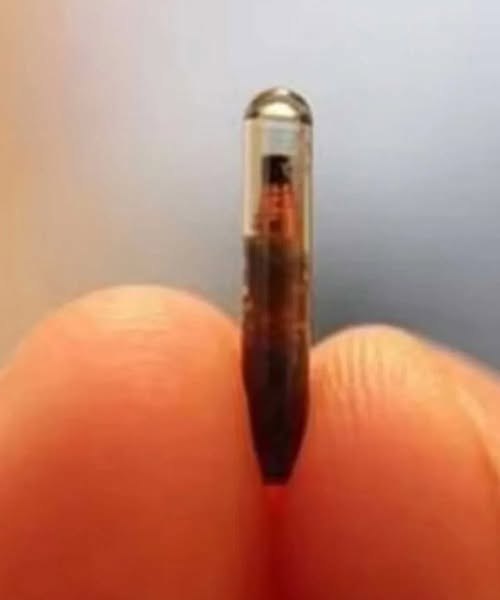Picture this: you sit down to enjoy a delicious meal, eagerly cutting into a juicy piece of meat, when suddenly, you spot something unusual. It’s small, flat, and seems to be stuck to the meat but not embedded in it. That’s exactly what happened to me recently, and it left me both confused and concerned. What could this strange object be, and how did it end up in my food?
After some research and reflection, I discovered that it might be an RFID (Radio Frequency Identification) tracker, a technology commonly used in the food industry. Let’s take a closer look at what RFID trackers are, how they are used in meat products, and what you should do if you encounter one in your food.
What Are RFID Trackers?
Radio Frequency Identification (RFID) is a technology used to track and manage products through electronic tags. These tags contain microchips that communicate with readers through radio waves, allowing for quick and efficient tracking. RFID technology is widely used across many industries, including logistics, retail, and food production.
In the food industry, RFID trackers are commonly used to monitor the movement of products throughout the supply chain. From the moment meat is processed and packaged, RFID tags help ensure the product’s origin, freshness, and quality. By tracking meat products, producers, retailers, and consumers can verify that the food has been stored properly, is safe to eat, and meets quality standards.
Why Are RFID Trackers Used in Meat Products?
The use of RFID technology in meat products serves a variety of purposes, all aimed at improving food safety, efficiency, and transparency. Some of the key reasons RFID trackers are applied in the meat industry include:
-
Tracking the Journey of Meat: RFID tags help track the entire journey of meat from farm to table. By providing detailed data about the product’s path, the technology ensures transparency and accountability at every stage of the supply chain.
-
Ensuring Freshness: RFID tags can help keep track of when the meat was packaged and how long it has been stored, ensuring that it remains fresh and safe for consumption.
-
Managing Recalls and Preventing Fraud: In case of contamination or a quality issue, RFID tags make it easier to identify and recall affected products quickly. They also help prevent food fraud by ensuring that meat is accurately labeled with its origin and processing details.
-
Improving Inventory Management: For retailers, RFID tags streamline inventory management by making it easier to track product quantities, reduce waste, and maintain accurate stock levels.
Identifying RFID Trackers in Your Food
RFID tags are small, flat, and often enclosed in protective materials, such as plastic. They may look like a sticker or a thin piece of plastic, and in some cases, they are attached directly to the product or its packaging. If you spot something unusual in your food, especially if it’s stuck to the meat but not embedded in it, it’s a good idea to examine the object closely. If it resembles the description of an RFID tag, then it’s likely just a part of the tracking process.
Health and Safety Concerns
While RFID tags are generally safe and are not intended to be consumed, there are some potential health and safety concerns. These tags are designed to remain outside of the food, usually on packaging, so accidental consumption is rare. However, if a tag becomes damaged or falls into the food, there could be risks, especially if the tag is made from harmful materials or contains substances that are not meant to be ingested.
If you find an RFID tag in your food, it’s important to carefully remove it and check for any damage. If you feel concerned or suspect the tag might have been compromised, you may want to consult a medical professional for peace of mind. It’s always better to be safe than sorry when it comes to food safety.
What to Do if You Find an RFID Tag in Your Food
If you discover an RFID tag in your food, here’s what you should do:
-
Remove the Object: Safely remove the RFID tag from your meal.
-
Inspect for Damage: Check if the tag is intact or if it’s been tampered with.
-
Contact the Supplier: If you’re concerned or if the tag is embedded in the meat, contact the store or supplier where you purchased the product to report the issue.
-
Consider Health Precautions: If you have any health concerns, don’t hesitate to reach out to a healthcare provider for advice.
Conclusion: Peace of Mind for Consumers
Finding an unexpected object in your food can be unsettling, but understanding the role of RFID trackers can help ease your concerns. These devices play a crucial role in ensuring food safety, quality control, and supply chain transparency. While RFID tags are generally safe, they are not meant to be consumed, and if you ever encounter one in your food, it’s important to handle the situation carefully. By staying informed and knowing what to look for, you can ensure your meals are safe and enjoy peace of mind when dining.

Sophia Reynolds is a dedicated journalist and a key contributor to Storyoftheday24.com. With a passion for uncovering compelling stories, Sophia Reynolds delivers insightful, well-researched news across various categories. Known for breaking down complex topics into engaging and accessible content, Sophia Reynolds has built a reputation for accuracy and reliability. With years of experience in the media industry, Sophia Reynolds remains committed to providing readers with timely and trustworthy news, making them a respected voice in modern journalism.
